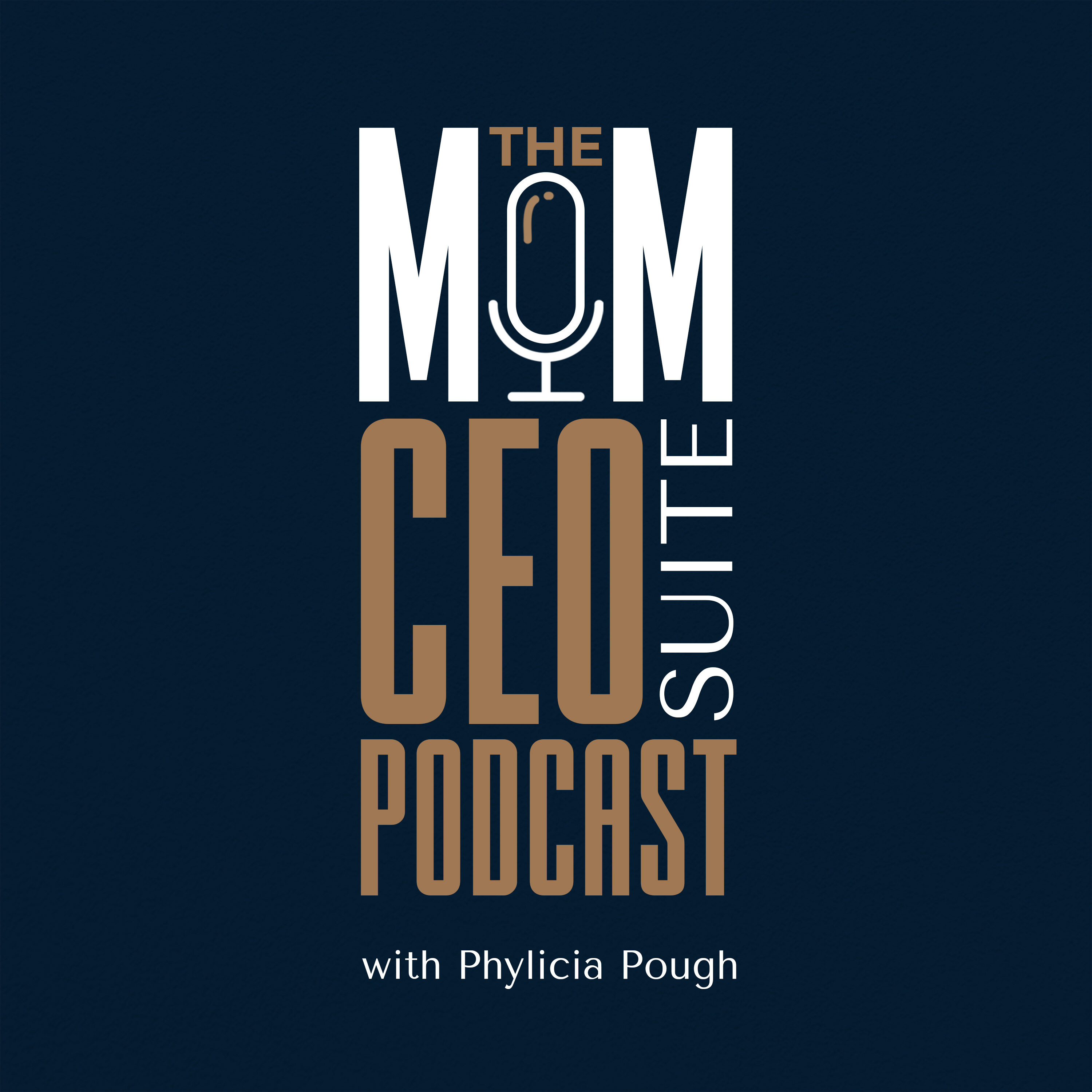Ep 83. Maximizing Your Time: Organize and Automate Your Business Successfully as a Mompreneur
In this episode, we're diving into the nitty-gritty of organizing and automating your business.
As a fellow mompreneur, I know how challenging it can be to juggle family, home, and business responsibilities. That's why I'm sharing six simple but powerful strategies to help you streamline your business operations and reclaim precious time.
First, we'll explore three ways to get your business organized. Then, we'll tackle three time-saving automation techniques.
LINKS & MENTIONS
- Register for the Moms Make Money Summit
- Get the Simple SOP Toolkit
- Try Flodesk (email marketing) & get 50% off your 1st year
RESOURCES
- The Mom CEO Suite Masterclass Collection: https://www.themomceosuite.com/masterclass
- CRM: Dubsado - Get 20% off your 1st month (if paying monthly) or 1st year (if paying annually)
- Livestreaming: Streamyard - Get a $10 credit
- Website Hosting: Showit - Get 1 month free
Connect with Phylicia
FB: Phylicia Pough
IG: @phyliciapough
Connect with The Mom CEO Suite
Website: themomceosuite.com
Instagram: @themomceosuite
Transcript
You are now tuned in to the mom CEO suite podcast.
Speaker:I'm your host, Felicia, wife, mom, and
Speaker:entrepreneur. In this podcast, I'll be sharing my mompreneur
Speaker:journey along with strategies that will help you build your online
Speaker:business operations in a sustainable way. The goal is
Speaker:to help you build a business that fits into your lifestyle as a mom who
Speaker:values putting family first. We will also hear the
Speaker:experiences and expertise of other moms with service
Speaker:based businesses. You'll get a peek into our journeys so you'll
Speaker:know that you aren't alone. Motherhood gets hard.
Speaker:Entrepreneurship gets hard. But together we can
Speaker:do hard things. Welcome to the suite.
Speaker:Hey, Fran. Welcome to another episode. Thank you so much for being here. So
Speaker:today I want to get into six ways.
Speaker:To organize and automate your business.
Speaker:And I'm going to break this up into two different parts. So first I'm
Speaker:going to talk about three ways that you can organize. And then I'm going to
Speaker:talk about three ways that you can automate. But why is this even
Speaker:important? Right? The whole point of this organization and
Speaker:automation. Is so that you, as a busy mom in business,
Speaker:you can maximize your time. Right? we're
Speaker:already kind of strapped for time between trying to run the
Speaker:business, managing things in the household, taking care of
Speaker:the children. Right. And so we don't want
Speaker:to waste time. In our business getting
Speaker:lost in the chaos and the messiness of an organization And then when
Speaker:we automate, we're able to save time because we're not
Speaker:manually, you know, performing specific tasks in our
Speaker:business. And so this is all about saving time for you
Speaker:as a busy mom in business. Okay. So the first thing let's talk
Speaker:about organizing. The first. Area that you
Speaker:can organize with the first way that you can organize is
Speaker:by creating a business hub. And
Speaker:when I say business hub, this is just like an area.
Speaker:This can be in your project management tool. I have mine and click up,
Speaker:you know, you can do it in a Sinai Trello, wherever you can just have
Speaker:a Google doc, but this is a business hub that really
Speaker:houses. All of your important business
Speaker:information and links. And so based on what your
Speaker:business is, you can decide what you actually put in there.
Speaker:Um, you know, if you have landing pages for all of your
Speaker:offers, you can put them in this hub. You know, if you
Speaker:have links to your social media
Speaker:accounts, You can put them in this hub, just so things are.
Speaker:Easily accessible. And when you need them,
Speaker:you know where to go to find them. And you're not scrolling
Speaker:through a bunch of different random folders. Or you're not
Speaker:scrolling through., a bunch of links.
Speaker:trying to remember what the link for something is. You
Speaker:go to your hub, you find the category that you're looking for and
Speaker:you grab the information that you need. Okay. So the hub that I
Speaker:have, actually, I'm a part of a, uh, like operational
Speaker:membership called the workflow studio. but she
Speaker:has lots of templates. And so in
Speaker:my. Hub. There's a category for
Speaker:sales and landing page. There's social media, um,
Speaker:appointment schedulers, lead magnets, affiliates, website links, client
Speaker:links. So whatever makes sense for you and your business, whatever those things
Speaker:are that you always are needing to grab. The
Speaker:information you want to create categories for that.
Speaker:Okay. The next, uh, area or the next way that you
Speaker:can organize is by having a press
Speaker:folder. Okay, this is super helpful.
Speaker:If you are participating in things like.
Speaker:bundles summits. If you are pitching yourself to be
Speaker:a guest on podcast, if you are doing guest blogging,
Speaker:any type of collaboration, this press folder will
Speaker:come in handy. And what you're putting in the press folder.
Speaker:Are your Bibles, so you can have different versions of your
Speaker:bio, like a short bio along by yo.
Speaker:Um, you can have. Your approved
Speaker:photos that people can use in promotional materials.
Speaker:You just have that all in the folder instead of again, If
Speaker:somebody asks you for this information, instead of having to
Speaker:scroll through all of the downloads on your computer, or,
Speaker:you know, trying to find the most recent version of your bio,
Speaker:it's already just in one place is in this press folder.
Speaker:And you can just send the link to that folder, to someone.
Speaker:Um, if they request your information, Or you
Speaker:can actually have this as a page on your website.
Speaker:And this will save you lots of time. Okay. Um,
Speaker:the next area that you can organize. Are your
Speaker:SLPs. Or a standard operating procedures.
Speaker:And you guys have heard me talk about SLPs here on the podcast.
Speaker:And so if you are in a place where you're needing to jumpstart,
Speaker:getting your SLPs created, you definitely want to check out
Speaker:my simple SLP toolkit that will be linked in the show
Speaker:description. But when it comes to your SLPs,
Speaker:Um, you definitely want to have some type of database and
Speaker:my database again, I use click up to kind of as my business
Speaker:up, like a mix between click up and, um,
Speaker:Google drive. And so.
Speaker:With my SLPs. Let me see if I can actually pull it up
Speaker:here. I have like there's a master list
Speaker:and. the master lists kind of just has all
Speaker:of the SLPs in one place. And then there's
Speaker:different categories and subcategories. It lists
Speaker:out. Um, Like the due date for when it
Speaker:needs to be updated. The last time it was updated who the
Speaker:process owner is, and then links to the actual like
Speaker:SOP document. And if you have any other
Speaker:accompanying, um, You know,
Speaker:documentation or support like video or screenshots or anything like
Speaker:that. But if I am. You know,
Speaker:looking for a particular SOP in the business, I know to come
Speaker:to the SOP master list, right? So instead of
Speaker:them just kind of, again, being in a bunch of different random places,
Speaker:your SLPs are in one central location is easily
Speaker:accessible and this is going to be super important. when you are.
Speaker:beginning to, or you might already be delegating
Speaker:tasks. Hiring contractors, hiring employees,
Speaker:having SLPs and having them organized in a central location is
Speaker:going to be very important and helping you in
Speaker:saving and maximizing your time. All right. So
Speaker:those are the areas that you can organize.
Speaker:and this wasn't on my list, but one of the things that I did recently,
Speaker:I organized by, um, My
Speaker:Google drive. And so again, this is
Speaker:another area that can get really cluttered really quickly,
Speaker:especially if you just create documents.
Speaker:And you forget to name them. I had a bunch of untitled documents.
Speaker:but it's really helpful if you create folders.
Speaker:For again, different categories based on the types of
Speaker:documents that you have creating different folders that
Speaker:will help just to keep your, your information. Just
Speaker:organized and in one place. So when it comes
Speaker:to automating. All right.
Speaker:There's tons of things that you can do. With automating
Speaker:your, your business, but I just want to talk about three quick
Speaker:things today. So number one now I
Speaker:know flow desk is super late to the party with this
Speaker:one. I use flow desk as my email marketing.
Speaker:Tool and they just, uh, released the
Speaker:feature. Not too long ago, link actions. So
Speaker:basically what link actions does is you
Speaker:can, uh, put a particular link in your email. And
Speaker:if someone clicks that link behind the scenes, specific
Speaker:actions can take place. So if somebody clicks a link, you can
Speaker:add them to a particular segment. the first time I
Speaker:used it, I, uh, announced.
Speaker:What was it? Oh, the prayer and connect call that I was
Speaker:thinking about doing. For moms and business. And
Speaker:so I sent an email to the list and I said, if you are
Speaker:interested, in this prayer and connect call, just click
Speaker:here. That's all you have to do. And once I
Speaker:decide what I'm going to do with this, you'll be the first to know.
Speaker:So what happened on the back end is that once they clicked Yvette
Speaker:particular link, There's an automation set up.
Speaker:Where their edit to a specific segment
Speaker:in my, um, email marketing. Uh, software.
Speaker:And so they didn't have to do anything once they clicked
Speaker:the link, though it redirected them. I created a page on my
Speaker:website. Um, which was a thank you page and,
Speaker:and then, I put the, podcast player on there.
Speaker:And so you can do this. For your
Speaker:business. If you already have people on your email list and you
Speaker:don't want them to. Have to sign up
Speaker:again, like fill out a form to sign up for something, right? This
Speaker:is reducing the friction.
Speaker:And getting a sale or a sign up. Okay. It's, it's
Speaker:less steps for, the people that's when your email list, all they have to
Speaker:do is click a button. You can add them to a particular segment
Speaker:or add them to a particular list and then redirect them
Speaker:to a thank you page. And you know, this could be, if you're having a
Speaker:webinar, Um, or, you know, you just have some
Speaker:other freebie. Or it's just some, something else of interest
Speaker:to them instead of having them sign up. Putting in their
Speaker:name, putting in their email address, they can just click a link. Okay.
Speaker:And then of course, you know, once someone is added to a particular segment in
Speaker:your email list, then from there, you can create a whole another set of
Speaker:workflows based on that segment. All right. So that's the first thing,
Speaker:link actions. If you want to try out flow desk.
Speaker:There will be a link in the show description. for you to receive
Speaker:50% off your first, uh, it's either your first
Speaker:month or your first year. but the details will be in the show description.
Speaker:The second way that you can automate in your business is to
Speaker:send. Automated surveys. And I
Speaker:included this one because. I've seen a
Speaker:lot of social media people. Forget this
Speaker:part in there. Client experience,
Speaker:right? You can, when you are off boarding your client, you
Speaker:can. just based on whenever their
Speaker:project date closes, you can set up some type of workflow.
Speaker:Or an automation that. However many days,
Speaker:right? Based on your preference, it could be three days. It could be a week.
Speaker:It could be the next day. Um, however many days after their
Speaker:project ends, you are sending them some type
Speaker:of survey or it could be. That it's included
Speaker:in the, um, you know, the final delivery email,
Speaker:or you can put this through. Wow. It doesn't have to be an offboarding. It
Speaker:could be. in the middle of the project at one of the,
Speaker:milestones. But you can
Speaker:automatically get feedback from people. You can embed that in your
Speaker:client experience. instead of just later on
Speaker:you know, six months after the project has ended going back
Speaker:and asking them for their feedback, right. You can just
Speaker:automatically include it. And receive the information, create a
Speaker:form. They can easily fill it out and you'll have that information when you
Speaker:need it. Okay. And then finally, I
Speaker:want to talk about Zapier.
Speaker:So Zapier, if you're not familiar, it is a.
Speaker:Tool. Um, so on my tool. That
Speaker:connects different apps to each other. And so.
Speaker:Through Zapier, you can connect things like Google drive and your
Speaker:email marketing software. Um, it's pretty much like if this, then
Speaker:that. So, for example, with the harmony private podcast,
Speaker:That is through, my podcast, host captivate.
Speaker:And so in order for people to actually get the emails,
Speaker:to get access to it and all of these things. Um,
Speaker:it's a paid product. So when people are paying through flow
Speaker:desk and so I have an automation set up through
Speaker:Zapier that says If somebody is added to this segment and the segment
Speaker:is attached to that particular paid product.
Speaker:Then add them to the, private
Speaker:podcast in captivate, and then that will trigger them to
Speaker:get access to the private podcast. Okay again.
Speaker:Instead of me having to manually see, oh, this person signed up or
Speaker:this person paid, let me go in and manually add them to
Speaker:the private podcast so they can listen. No, it's all automatically done
Speaker:through Zapier. And so there's tons, tons of things that you
Speaker:can do. through Zapier. I use it a lot. Um, connecting,
Speaker:dub cyto and click up. I use it a lot for my Podcast guests
Speaker:management workflow. I've talked about that already before previously here on the
Speaker:podcast. But as an example, what are some things that you
Speaker:can do? Um, with Zapier.
Speaker:So. Let's just say you are a service
Speaker:provider, you can do something like, when a new project
Speaker:is created in your CRM. Right. Or if a
Speaker:contract is signed in your CRM. Then you can create
Speaker:a task. In click up
Speaker:or whatever your project management tool is. Okay.
Speaker:And so for me, for example, in click up.
Speaker:There's also automations within click up. itself
Speaker:that if a task is created, then you can do something like apply
Speaker:a template to a particular task. When a task is created in a specific
Speaker:list. And one of the templates that I have is like a checklist
Speaker:for, my podcast production. So anytime I create a
Speaker:task for a new episode. The
Speaker:Ms. Checklist is automatically added. And so now I know
Speaker:for each episode, all the things that I need to do well, you can do
Speaker:the same thing for your clients, right? Once you get a new
Speaker:client, then you can have a checklist of all of the things that need to
Speaker:happen for that particular client and automatically apply
Speaker:that to the task in your project management tool.
Speaker:Okay. Um, And then you can
Speaker:take a step further if you really want to get advanced. And
Speaker:once that task is created in your project management tool.
Speaker:Thing, you can create a Google folder,
Speaker:right. And that is done through Zapier. So lots of
Speaker:connections, lots of things that you can do
Speaker:through that tool. And I would really encourage you to just sign
Speaker:up for a free. Um, a free plan there's
Speaker:limitations on the free. plan, but that's the plan that I'm using
Speaker:right now. And it does what I needed to do. There's a few
Speaker:things that I'm able to do. On the free plan.
Speaker:And so just go set up a free plan and test and play with things
Speaker:and see what the possibilities are. I know they've added like
Speaker:this AI feature. Where you can just kind of type in what you
Speaker:want to do, and it will create the zap.
Speaker:Uh, for you and then you can test it out.
Speaker:Just right there instead of you having to like already know what the
Speaker:zap is that you need to do. All right. So.
Speaker:Again, Just wanted to give you some quick ways that
Speaker:you can organize. Or automate your business.
Speaker:Um, with the ultimate goal of saving and
Speaker:maximizing your time. So just to do a quick, just to
Speaker:do a quick recap, if you want to organize. Um, you can create
Speaker:a biz hub. You can create a press folder. Or you can create
Speaker:SLPs. And if you want to automate. Some of the
Speaker:automations that you can implement are link actions,
Speaker:sending automated surveys or using Zapier to connect
Speaker:your different apps. So I would love to hear
Speaker:if you are doing any of these things. If so
Speaker:DME on Instagram, let me know what you're doing. And if not,
Speaker:I still want to hear from you. I want to know which ones are you.
Speaker:Most intrigued by which ones do you want to
Speaker:implement? Okay. So shoot me a message on Instagram.
Speaker:I look forward to hearing from you. And I will see you in the
Speaker:next episode. Thank you for listening to the Mom CEO
Speaker:Suite Podcast. If you enjoyed this episode, can you do us a
Speaker:favor? Leave a review on iTunes and share with other
Speaker:moms in business like you. Help us spread our message and empower
Speaker:others who are at this intersection of motherhood and
Speaker:entrepreneurship.


